Iwamoto M., Kwon Y.-S., Lee T. (Eds.) Nanoscale Interface for Organic Electronics
Подождите немного. Документ загружается.

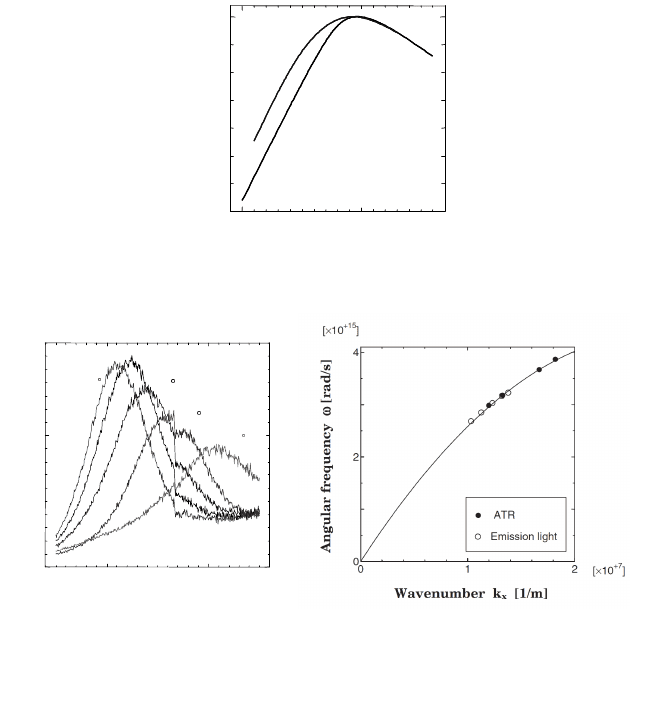
Surface Plasmon Excitations and Emission Lights in Organic Films 259
The dispersion property of SP represents a relation between the
wavenumber k
x
of SP in the x-direction as shown in Fig. 14 and
the angular frequency
ω of the wavelength λ. k
x
and ω are given by the
following equations:
k
x
= n
p
ksin
θ
= n
p
(2π/λ)sin
θ
(4)
ω = kc = (2π/λ)c (5)
where n
P
is the refractive index of the prism, k (= 2π/λ) is the
wavenumber of light in air and c is the light velocity in air. For the ATR
Fig. 16. Relation between emission intensities and separations of MC LB layers from metals.
(a) (b)
Fig. 17. Spectra of emission lights (a) and dispersion properties (b). Emission lights were
measured for Ag/C20(2 layers)/MC(16 layers) sample at various emission angles. The
dispersion properties were calculated from ATR and emission light properties.
600 700
Wavelength [nm]
Photon count [a.u.]
θ
θθ
θ
e
=50º
51
49
48
46
600 700
Wavelength [nm]
Photon count [a.u.]
θ
θθ
θ
e
=50º
51
49
48
46
Al Ag
Number of Layers
Normalized light intensity
1L 5L 9L 13L
Al Ag
Number of Layers
Normalized light intensity
1L 5L 9L 13L

K. Kato 260
properties,
θ
is the resonant angle of SP and λ is the wavelength of the
incident light. For the emission light measurement,
θ
is the angle of
the peak intensity of emission spectrum and
λ is the peak wavelength.
Figure 17(b) shows the dispersion properties. Closed and open circles
indicate the properties obtained from the ATR and the emission light
measurements, respectively. The dispersion property of the emission
lights agreed well with that of the ATR measurements. It was thought
that multiple SPs were simultaneously excited by the reverse irradiation
and the emission light was generated due to the dispersion property of SP
in the Kretschmann ATR configuration of the prism/Ag/C20/MC LB
film. Similar emission lights through the prism are reported for the
Ag/Rhodamine-B (RB) LB film by the resonant excitations of SPs in the
conventional ATR method and the calculated dispersion properties also
coincide with one of the ATR measurements.
7
Figure 18 shows the emission light for luminescent molecular films
due to SP excitation. The SP emission lights involve the following
processes. The excitation of SPs directly occurs by the excited MC
molecules and/or through the surface roughness, and then the light
emission is coupled with the excited SPs through the ATR prism, where
the SP emission is influenced largely by the film properties with the MC
molecules and/or by the metal surface roughness. It is tentatively
estimated that small emissions are due to non-radiative energy transfer or
charge transfer
32
from the excited MC molecules to the metal thin film in
the small separations and due to smaller induced charges on the metal
thin film in the large separations. The electromagnetic modes localized at
Fig. 18. Emission light for luminescent molecular films due to SP excitation.
k
//
Evanescent wave
k
1
Emission light
k
sp
Surface plasmon
k
0
Incident light
Molecule (excited)
Metal
Prism
Near-field Interaction
k
//
Evanescent wave
k
1
Emission light
k
sp
Surface plasmon
k
0
Incident light
Molecule (excited)
Metal
Prism
Near-field Interaction

Surface Plasmon Excitations and Emission Lights in Organic Films 261
the surface are induced by dipoles with electromagnetic waves and have
suggested that the dipole-surface interaction will be very important for
device applications utilizing near-field optics. It is thought that the
phenomenon is very useful for nanostructured device applications.
4.2. SP Emission Lights due to Molecular Luminescence
and Interaction
SP emission lights have been investigated for rhodamine-B (RB)
LB films. RB is a photosensitizing organic dye showing strong
photoluminescence. Figure 19 shows the emission lights as a function
of emission angle for the prism/Ag/C20/RB LB films with various
separations between the Ag and the RB LB films under the reverse
irradiation with two polarized laser beams.
9
The SP emission lights in
Figs. 19(a) and 19(b) strongly depend upon the thickness of the
separations and show the maxima with the separation of 8 layers. The
properties depending upon the separation were similar to that of the
photoluminescence. The emission peaks by the p-polarized laser at 0°
with the electric fields parallel to the observation plane were much larger
than those by the s-polarized one at 90° and the peaks by the s-polarized
beam were approximately 15% of those by the p-polarized one.
(a) (b)
Fig. 19. Emission light for the RB LB film using p-polarized light (a) and s-polarized
light (b) at 488.0 nm under reverse irradiation.
40 50 60 70
0
0.01
0.02
12layers
Emission light intensity [arb.units]
λ =488.0 [nm] RB C20=1 5
Emission angle [deg]
0layers
4layers
8layers
40 50 60 70
0
0.001
0.002
0.003
Emission light intensity [arb.units]
λ =488.0 [nm] RB C20=1 5
Emission angle [deg]
12layers
8layers
4layers
0layers

K. Kato 262
Since orientations of the RB dyes were thought to be almost uniform
in the LB film plane, it is tentatively estimated that some RB dyes having
the long axis parallel to the polarized plane of the laser were mainly
excited by the reverse irradiation, and these excited dyes induce
anisotropic SPs which propagate along the Ag surface, which can be
observed mainly in the observation plane of the half-cylindrical prism.
Figure 20 shows the SP emission due to p- and s- polarized laser beams
in the reverse irradiation. Anisotropic molecules are excited mainly by
the polarized laser beam with the electric fields parallel to the molecular
transition moment. The emission phenomenon includes conversions from
three- to two-dimensional optical waves and those from two to three-
dimensional ones. It is thought that the SP emission properties depending
upon the very short separation of the RB from the Ag are very useful for
conversion between three- and two-dimensional optical waves.
Figure 21 shows the emission light curves as functions of the
emission angle
θ
e
for the MC LB film (16 layers) and the MC/CV hetero-
LB film (16 layers) due to the reverse irradiation of p- or s-polarized
laser beams at 488.0 nm.
10
For the MC and MC/CV hetero-LB films, the
peak angles did not depend on the polarization direction of the excitation
light. However, the emission light intensity dependence on polarization
direction differed between the films. The SP emission light intensity was
high for the p-polarized excitation light of the MC LB film, as shown in
Fig. 21(a). For the emission light curves of the MC/CV hetero-LB film,
the light intensity did not depend on the polarization direction of the
Fig. 20. SP emission due to p- and s- polarized laser beams in the reverse irradiation.
s-pol.
p-pol.
SP
SP
SPSP
SP
SP
SPSP
Emission light
Emission light
Prism
Incident lightIncident light
LB film
Excited Molecule
S-polarized laser P-polarized laser
s-pol.
p-pol.
SP
SP
SPSP
SP
SP
SPSP
Emission light
Emission light
Prism
Incident lightIncident light
LB film
Excited MoleculeExcited Molecule
S-polarized laser P-polarized laser

Surface Plasmon Excitations and Emission Lights in Organic Films 263
excitation light. The spectra of SP emission lights strongly depend on
θ
e
.
Figure 22 shows the emission light due to SP excitations via energy
transfer between molecules.
4.3. Application of SP Emission Lights to Organic Devices
Figure 23 shows the emission lights measured at 488.0 nm from the
prism/Ag thin film/ Aluminum phthalocyanine chloride (AlClPc) thin
film structure.
33
The intensity of the emission light is normalized as the
(a) (b)
Fig. 21. Emission light intensity curves of MC LB film (a) and MC/CV hetero-LB films
(b) observed using p- and s-polarized excitation lights.
Fig. 22. Emission light due to SP excitations via energy transfer between molecules.
k
0
Incident light
Energy Transfer
Near-field Interaction
Molecule 2
Metal
Prism
Molecule 1
k
//
Evanescent wave
k
1
Emission light
k
sp
Surface plasmon
k
0
Incident light
Energy Transfer
Near-field Interaction
Molecule 2
Metal
Prism
Molecule 1
k
//
Evanescent wave
k
1
Emission light
k
sp
Surface plasmon
20 40 60 80
Emission angle
e
[deg.]
Light intensity [a.u.]
Ag/C20(2L)/MC(16L)
p–pol.excitation
s–pol.excitation
40 60
p–pol.excitation
s–pol.excitation
Emission angle
e
[deg.]
Light intensity[a.u.]
Ag/C20(2L)/(MC:2L/CV:2L)4L
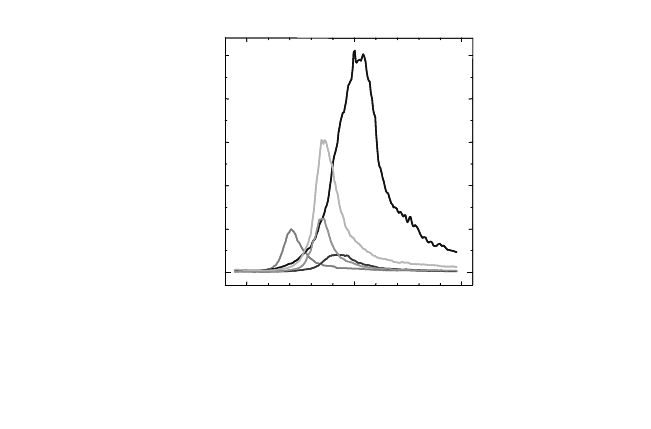
K. Kato 264
peak intensity of the Ag thin film is unity. The peak angles of the
emission light curves correspond to resonant angles of ATR curves,
which suggests that the emitted lights were due to SP excitations. The
intensity of SP emission light through the prism strongly depends on the
nanostructures such as surface roughness of the organic and metal thin
films in the Kretschmann configuration. Figures 24(a) and 24(b) show
the AFM images of the as-deposited AlClPc thin film on Ag thin
film and the film treated with ethanol vapor for 10 min, respectively.
Themean roughnesses R
a
evaluated from the AFM measurement were
1.6 nm and 9.7 nm for the as-deposited and ethanol-vapor-treated AlClPc
thin films, respectively. The surface roughness of the AlClPc thin
film was found to increase markedly with ethanol-vapor treatment. The
increase of 8.1 nm in the surface roughness of the film due to the
ethanol-vapor treatment is extremely large against the thickness of about
10 nm for the as-deposited film. Therefore, the result of the SP emission
lights in Fig. 23 was considered to be caused by the large surface
roughness of the AlClPc thin film due to the treatment with ethanol
vapor. The SP emission light due to molecular luminescence is also
applied to the sensing devices using poly(vinyl alcohol) films with
fluorescent microsphers.
34
Fig. 23. SP emission lights measured at 488.0 nm from the prism/Ag thin film/aluminum
phthalocyanine chloride (AlClPc) thin film structure. a: as-deposited, b: ethanol-vapor-
treated, c: H
2
O-vapor-treated, d: H
2
O-vapor-treated after ethanol-vapor-treated.
40 50 60
0
2
4
Emission angle [deg.]
Normalized Light intensity
a
b
c
d
Ag
40 50 60
0
2
4
Emission angle [deg.]
Normalized Light intensity
a
b
c
d
Ag
Normalized light intensity
Emission angle [deg.]
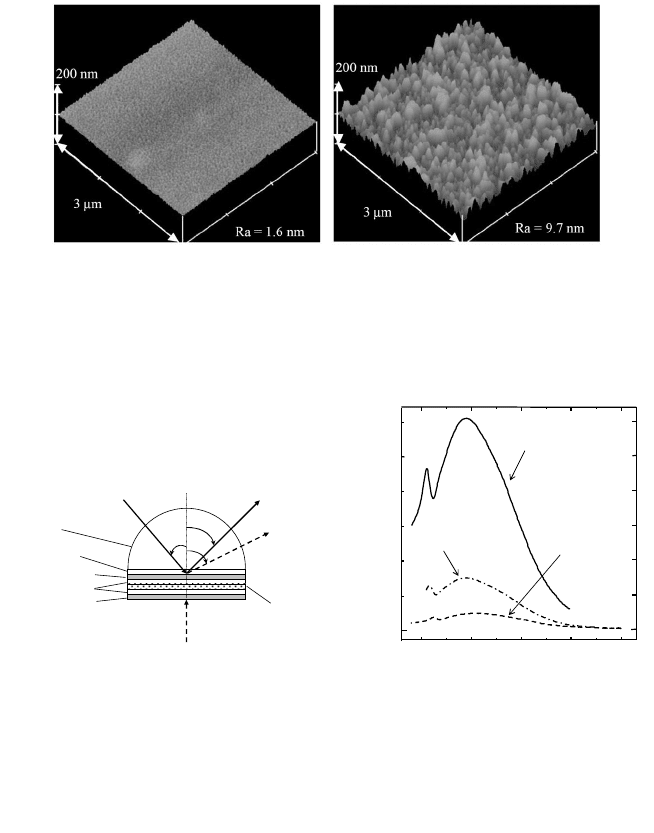
Surface Plasmon Excitations and Emission Lights in Organic Films 265
The ATR and SP emission lights have been investigated in the
prism/Ag/MgF
2
/organic dye/MgF
2
/Ag structure. Poly(2-methoxy-5-
(20-ethyl-hexyloxy)-1,4-phenylenevinylene) (MEH-PPV), which is a
photoluminescent dye, was used as the organic dye. Figure 25(a) shows
the sample configuration.
35,36
The emission light properties for the
(a) (b)
Fig. 24. AFM images of AlClPc thin films on Ag thin films before and after the treatment
with ethanol vapor. (a) and (b) show the results for the asdeposited and ethanol-vapor-
treated AlClPc thin films, respectively.
(a) (b)
Fig. 25. Sample configuration of ATR and SP emission light measurements for the
Ag/MgF
2
/MEH-PPV/MgF
2
/Ag structure (a) and the emission light properties for the
Ag/MgF
2
/MEH-PPV/MgF
2
/Ag sample measured at 488.0 nm by the usual and reverse
irradiations (b).
reflected light
(ATR signal)
Ag
MgF
2
Ag
θ
i
p-polarized incident light
θ
r
=
θ
i
θ
e
cover glass
half-cylindrical prism
MEH-PPV
p-polarized incident light
for reverse irradiation method
emission light
40
50
60
70
80
0
0.2
0.4
0.6
Emission angle [deg.]
Emission light intensi
ty [a.u.]
usual (θ
i
= 0°)
reverse
usual (θ
i
= 72.0°)
K. Kato 266
prism/Ag(25 nm)/MgF
2
(100 nm)/MEH-PPV(40 nm)/ MgF
2
(60 nm)/
Ag(40 nm) structure are shown in Fig. 25(b).
35
The emission light
measured at the incident angle
θ
i
of 72.0° of SP excitation had the largest
intensity. The emission angle corresponded to the resonant angle of the
ATR curve measured at around the photoluminescence wavelength of
the MEH-PPV dye. It was found that the emission light intensity and the
spectra strongly depended on the emission angles and the emission light
was also related to the photoluminescence of the organic dye. The SP
emission lights can be controlled by the inserted dye layer and are useful
to device applications.
4.4. Electrochemical SP Excitations and Emission Lights
SP excitation and the emission light properties are investigated in the
doped and dedoped states of regioregular poly(3-hexylthiophene-2,5diyl)
(P3HT) thin films.
37
Electrochemical experiments were performed in a
conventional three-electrode cell with the Au/SFL11 glass substrate as
the working electrode, a platinum wire as counter electrode, and an
Ag/Ag
+
nonaqueous reference electrode in acetonitrile solution with 0.1 M
tetrabutylammonium hexafluorophosphate (TBAPF
6
) as a supporting
electrolyte. The experimental setup for the electrochemical ATR and
emission light measurements utilizing the SP excitations is shown in
Fig. 26.
37
A Kretschmann configuration of highly refractive prism
(SFL11)/Cr/Au/P3HT thin film/acetonitrile solution containing an
electrolyte (TBAPF
6
) structure was used for the measurements. SPs were
excited at the metal–dielectric interface, upon total internal reflection of
polarized light from a He–Ne laser with the wavelength of 632.8 nm. The
optical/electrochemical processes at the Au thin film were detected by
monitoring the reflectivity as a function of the incident angle. The SP
emission light was obtained by the irradiation of Ar
+
laser beam with
thewavelength of 488.0 nm. The P3HT thin filmwas luminous upon the
light irradiation, and excited SP emission light was measured. A sharp-
cut filter that eliminates incident light was used for the measurement of
SP emission light intensity. The SCF enables the observation of only
SP emission light due to excited fluorescent organic molecules.
A photomultiplier tube was used for detecting the emission light.
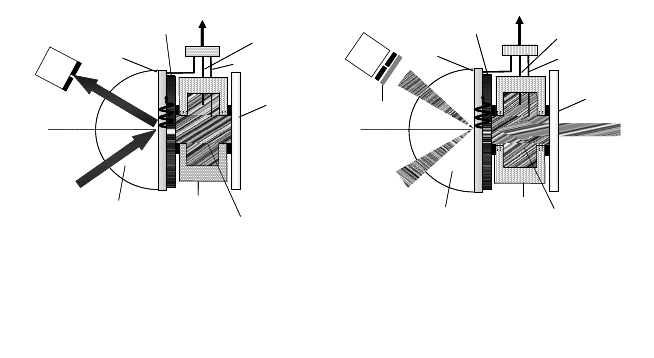
Surface Plasmon Excitations and Emission Lights in Organic Films 267
A constant potential was applied to the P3HT thin film and the change of
SP emission light properties was observed upon doping and dedoping of
the P3HT thin film. The SP emission light is observed due to the
molecular luminescence of P3HT.
The electrochemical ATR properties of the P3HT thin film applied at
constant potentials are shown in Fig. 27(a) for the doped-state P3HT thin
film.
37
It is found that the dip of the ATR curve becomes deeper with
increase of the applied potential and the resonant angle changes with the
doping of the P3HT thin film. From the ATR properties, the dielectric
constants of the P3HT films are found to change remarkably with the
doping. On the contrary, the ATR curve hardly changes with the
dedoping. These ATR properties correspond to the optical absorption
properties well.
Figure 27(b) shows the electrochemical SP emission light properties
of the P3HT thin film applied at constant potentials.
37
The SP emission
light in the undoped state is observed at the emission angle of around
52°. The intensity of the SP emission light decreases in the doped state at
0.2 V. At 0.4 V, the SP emission light is hardly observed. The emission
light properties correspond to the resonant conditions of SPs in the
Kretschmann configuration, and it is considered that multiple SPs are
induced due to the excitation of P3HT molecules by the incident light
and that the SPs are converted into emission light through near-field
coupling. It is considered that the SP emission light excited by the
(a) (b)
Fig. 26. Experimental setup for the electrochemical measurements of ATR (a) and SP
emission lights (b).
counter electrode
organic thin film
cover glass
incident light
SP
detector
highly refractive prism
electrolysis cell
reference electrode
metal thin film
potentiostat
electrolyte solution
counter electrode
organic thin film
cover glass
incident light
SP
detector
highly refractive prism
electrolysis cell
reference electrode
metal thin film
potentiostat
electrolyte solution
reference electrode
incident light
SP
detector
sharp-cut filter
organic thin film
metal thin film
potentiostat
counter electrode
cover glass
highly refractive prism
Teflon cell
electrolyte solution
reference electrode
incident light
SP
detector
sharp-cut filter
organic thin film
metal thin film
potentiostat
counter electrode
cover glass
highly refractive prism
Teflon cell
electrolyte solution
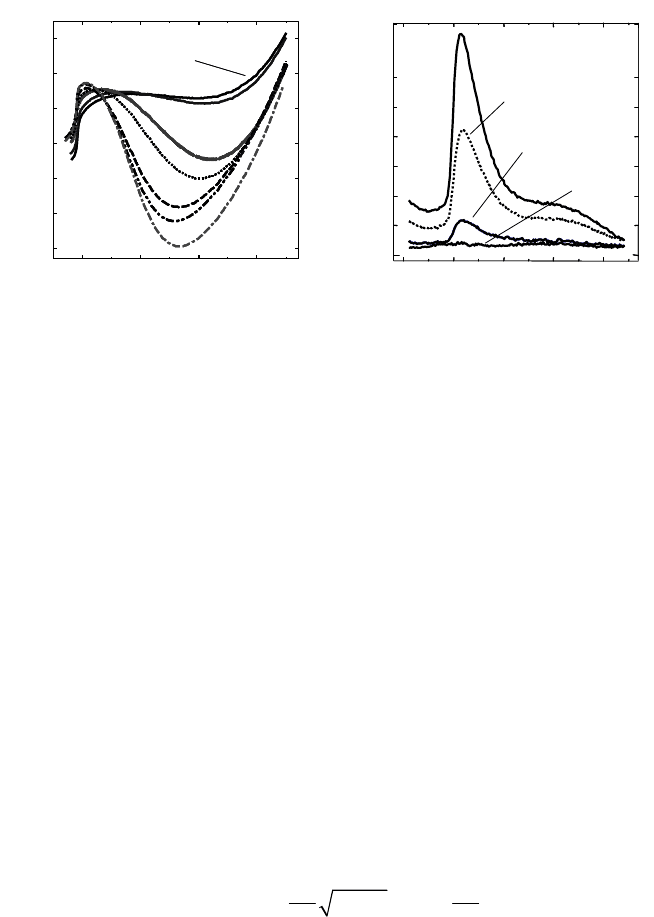
K. Kato 268
molecular luminescence decreased since the molecular luminescence of
P3HT became weaker at the doped state. On the other hand, since a
strong molecular luminescence of P3HT is obtained in the dedoped state,
it is considered that the SP emission light in the dedoped state increased
as can be seen in Fig. 27(b). The reversible change of the SP emission
light was observed by the doping and the dedoping. The SP emission
light excited by molecular luminescence can be controlled by the control
of doping–dedoping state.
4.5. Grating Coupling SP Excitations and SP Emission Lights
Figure 28 shows the configuration for the diffraction grating SP
excitation. The SP dispersion branches at the interface between the metal
grating and air. These branches are obtained by the following equation:
2
π 2π
ε (ω) sin
λ
sp px m
k k G m
θ
= + = +
Λ
(6)
where
Λ is the diffraction grating pitch, λ is the wavelength, m is the
diffraction orders, and
ε
m
(ω) is the wavelength-dependent dielectric
(a) (b)
Fig. 27. Electrochemical ATR and SP emission light properties of the doped-state P3HT
thin film applied at constant potentials. (a) ATR properties, (b) SP emission light
properties.
40 60
80
0
0.002
0.004
0.006
Emission angle [deg.]
λ = 488.0 nm with SCF
initial state
(undoped state)
doped state (0.2V)
dedoped state (–0.4V)
doped state (0.4V)
Emission light intensity [arb. units]
50 60
70
80
0.2
0.4
0.6
0.8
Reflectivity
Incident angle [deg.]
λ
= 632.8 nm
0.2V
0.3V
0.4V
0.6V
0.8V
0.9V
initial state (undoped state)
50 60
70
80
0.2
0.4
0.6
0.8
Reflectivity
Incident angle [deg.]
λ
= 632.8 nm
0.2V
0.3V
0.4V
0.6V
0.8V
0.9V
initial state (undoped state)
